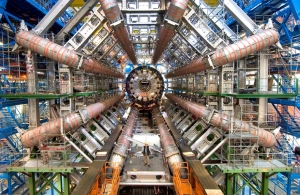A great bio doc is out now on his life. I watched it and was inspired to write this pseudo-summary piece:
http://peacemagazine.org/archive/v27n1p24.htm
Take a look at some other PeaceMag articles, too. It’s a solid publication.
Physics is the study the physical world and what it is made of. So what is it made of? The ancient Greeks (in their togas and brilliance) came up with, among many other things, the idea of an indivisible piece from which all other matter was made. They called it the ‘Atom’. People like Einstein did research that helped this concept become a reality at the turn of the last century.
Then, people started finding smaller parts within the atom, the concept applied to even smaller scales: an electron around a nucleus that itself was made of protons and neutrons. But the Greek’s concept of the ‘true Atom’ kept physicists searching. To delve deeper, they had to resort to what at first glance seems ridiculously brutish: smash a known particle with another and watch the pieces that fly out. Nevertheless, a large proportion of physicists have devoted the last 60 years to doing just that. A ‘smash’, however, is only as good as the ‘umph’ that each particle brings to the collision, so physicists have been making larger and larger ‘accelerators’ in order to get more energetic collisions.
Enter the Large Hadron Collider (LHC). This accelerator is able to smash particles together with up to 30 times more energy than anything ever built. In fact, it will be able to get down to scales for which we only have theories. For that reason, the tens of thousands of experimental physicists that that have devoted their careers to the LHC will be joined by the tens of thousands theorists that have for over the last 30 years developed theories that predict what everyone will see when it is up and running.
The LHC begins to turn on this Wednesday for the first time. Needless to say, it is a serious event for alot of people. Decade old theories will soon triumph or be tossed.
The human element is interesting here. Being the skeptics that they are, the community has prepared itself for failure. Research beyond the LHC abounds. However, what if the soon-to-be-tested theories are right? Plans for any new accelerators may be axed for lack of need. That’s a lot of people out of work.
That’s science.
Tune in this Wednesday at 9am to see the fate of those CERN scientists.
For more info on LHC’s ‘first beam’, click here.
For an interactive picture explanation on how the LHC works, click here.
Postscript: So the day has come and gone as a success. The first full on interactions will be in a couple weeks; give it a couple month for good data; and until the beginning of next year for publishing results.
For Nick: For the views of some popular theoretical physicists as to what the LHC will find, see the Daily Telegraph article (Thanks Willy)
Filed under: physics
While on the western shores of the island of Chiloe in southern Chile, I came across some patterns in the receding waves. As an aspiring physicist, I immediately starting creating a toy model:
In general terms, the patten is a result of water flowing down a shallow and almost featureless incline made of granular matter. As water pulls back (gaining speed), the minuscule, yet inevitable deviations from the flat surface of the sand grow and organize into small humps (perhaps analogous to the washboard road effect, what do you think, Stephen?). The flow of water has to move over the humps in such a way that it makes them visible. Sometimes, a sort of smooth honeycomb cell structure emerges, at other times, the humps are long disconnected strands, more or less perpendicular to the flow. Then another waves comes in and the process starts all over again…
Filed under: physics
Check out my favorite encounter with the cornstarch monster, brought to you by the fun science guys at the Center for Nonlinear Dynamics at the University of Texas at Austin.
They don’t give much background so here’s a short primer:
When we think of liquid, we think of fluidity. In science, that’s called vicosity, or how much resistence that liquid puts up against a force, or stress on it. The viscosity of most liquids doesn’t change when we apply a stress on them (like sticking our fingers in). In other words, the relation between the stress that we apply and the strain (or deformation) that the liquid does, is proportional. We push a bit; it gives a bit. We push alot; it gives alot. We call these Newtonian liquids. (Man, that guy is everywhere.)
Okay, but what if it’s not Newtonian? That means that the viscosity changes as we apply a stress to the liquid…so you can get more resistance the more force you apply.
So…Could you turn a liquid into a solid simply by trying to stick your finger in it? …well, sort of.
A thick mixture of cornstarch and water is a non-Newtonian liquid, and it can do some pretty crazy things. Once again, the best part is the end:
Click here to learn how make your own cornstarch monster from a coffee can and old computer speakers. Add colouring, and presto! You’re fading the boundaries between art and science! A person of the new millenia you are!

